
Retail fashion has taken a big economic hit and faces an ongoing challenge because of this year’s pandemic.
The recent changes and economic hurt in the fashion industry, as a consequence of the COVID-19 pandemic, have resulted in an acceleration of several transformative technological trends. The transformative trends are no longer just attractive additions to retail experiences but are essential to assisting luxury houses and fashion brands in recovering and rebuilding from the economic downturn many have faced while maintaining their ecological goals. The pandemic has not just affected the in-store experience, but also the wholesale marketplace and runway experiences for buyers and industry influencers. Technological solutions present an attractive investment opportunity at this time both from brand and economic standpoints.
The apparel industry is one of the most valuable sectors of the economy in terms of investment, revenue, trade and employment. "In 2019, the value of the personal luxury goods market worldwide was $314 billion with an estimated annual growth rate of 5.5% since 2015. The luxury apparel industry represented $72 billion of the total personal luxury goods and 9% of its sales are generated from online retail." (Bain &Co., 2019.)
Until 2020, the luxury apparel industry had seen consistent growth despite any challenges brands may have faced. The marketplace has a long history of resilience and innovative minds when faced with seemingly overwhelming challenges. In contrast to low-profit-margin “fast fashion” brands that rise and fall in just a few years, Hermès was founded in 1837, Louis Vuitton in 1854, Burberry in 1856, Chanel in 1906, Prada in 1913, Balenciaga in 1919, and Gucci in 1921. Such brands have endured past pandemics, world wars and depressions by adopting new marketing approaches, taking advantage of emerging technologies and pivoting business strategies. Luxury fashion was one of the industries significantly impacted during the 2008 Recession, contracting 9% globally, however it made one of the strongest comebacks, compared to 300 US fashion companies that declared bankruptcy due to the financial crisis. (“The State of Fashion – 2020,” McKinsey&Co. & BOF).
We are already witnessing signs of a strong comeback for some luxury brands as industries begin to slowly reopen after the COVID-19 outbreak. The reopening of the Hermès Guangzhou flagship had a turnover of $2.7M in a single day during its reopening phase (“How the COVID-19 crisis could remodel the luxury industry” the conversation.com). The luxury fashion industry is better prepared, than in past recessions, as brands rely less on wholesale and thus are in more control of their customer relationships.
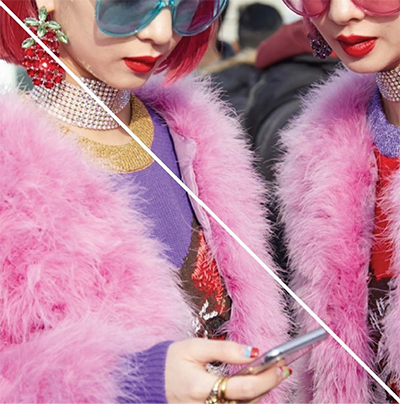
The increased role of e-commerce and media platforms has kept luxury brands more closely connected with consumers even during the lockdown and the consumer sentiment in China, the fastest growing market, remains positive.
Even before the lockdowns and supply chain disruptions caused by the pandemic, industry analysts and brands themselves were largely in agreement that changes were overdue in multiple aspects of the business operations and customer centricity of the segment. These needs remain equally urgent in the post-crisis environment, more notably the same fashion tech developments that address these industry challenges, virtual try-ons, virtual runways and B2B virtual marketplaces, are also solutions to the added complications resulting from COVID-19.
In a survey by the Textile Clothing Technology Corporation, 68% of customers reported that they have an aversion to trying on garments because they find the experience unpleasant. However, those who use fitting rooms are 7x more likely to purchase and make 50% fewer returns. (crgworldwide.com).
A survey from First Insight reports that 65% of women and 54% of men do not feel safe trying on clothes in fitting rooms, in a post-COVID-19 world. ("Scared to return to the fitting room? Contactless fit has you covered." Sourcing Journal).
Even for those shoppers who are willing to try on garments post-pandemic, the situation from a retailer perspective is economically and logistically unsustainable. Regional governmental regulations and store policies around the world dictate that garments that are tried on must be quarantined for 24-72 hours. Thus, quickly depleting store stock or necessitates having many duplicate items in stock for try-on, which in the luxury fashion industry is economically impractical as all those items can’t be sold during their active season.
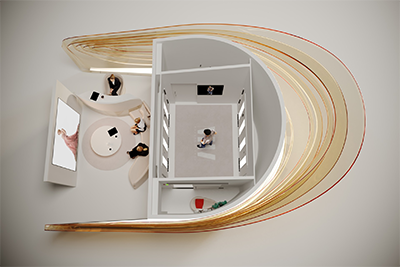
Photo Credit: Modern Mirror AFS Image Cabin
“Virtual try-on is no longer a
nice to have, but a
must-have."
Virtual fit technology, which in its highest-fidelity instantiation not only ascertains which size of a given garment will best fit an individual but also shows a dynamic 3D visualization of the garment on the shopper’s own body. Contactless virtual try-on solutions offer the economic and customer-satisfaction advantages of physical try-on while avoiding problems with customer anxieties and the logistical headaches of managing quarantined try-on inventory and can make the difference between uneconomic and profitable physical retail operations. These technologies can provide an equivalent experience to the physical try-on of the garment where customers can discover and try-on more garments in less time without experiencing fatigue, and without any concerns for retailers in maintaining an excessive amount of stock in every size.
While online shopping continues to increase in popularity, so do return rates for the fashion industry. The estimated number of online returns is increasing at a staggering rate causing not only a negative impact on the environment, but also on brands’ bottom lines and operations due to shipping, packaging, warehousing and restocking costs. It is estimated that sizing is responsible for nearly three-quarters of the 40 - 50% return rate of garments purchased online, because customers purchasing online cannot try-on garments, resulting in high return rates of merchandise and even lower conversion rates for luxury retailers. Forty percent of online shoppers admit to buying multiples of one style garment with the intent of returning 3 out of the 4 garments to find the best fit.
Fashion brands are losing anywhere from 10 - 30% of their revenues from returns, not including merchandise losses when garments have been returned and are unable to be resold, due to timing or the condition of the piece. In the UK alone, returns amount to costing £20 billion a year in associated costs.
It has been estimated that worldwide, approximately 17 billion items are being returned every year, which comes at a cost of 4.7 million metric tonnes of CO2, emitted annually (“There is no such thing as a free return,” Gulna Khusainova, Forbes). Overproduction or mis-allocation of sizes across geographical locations are major problems for luxury brands when forecasting inventory for each collection, leading to excess that cannot be marked down or easily discarded or recycled. If online buyers are provided with the confidence in fit that in-store physical try-on provides, and brands can have a clearer picture of the regional fit demographics and preferences of their customers, the overproduction and unnecessary transportation of merchandise can be minimized.
Fashion weeks have been pivotal in presenting upcoming collections and inspiring audiences with the latest runway designs. However, quarterly fashion events have already been under fire as massive contributors to the sustainability issues brands face; The Carbon Trust has calculated that travel to such events emits 421,000 tonnes of CO2 annually. By necessity, fashion weeks have temporarily moved online, analysts and event organizers have concluded that even when physical shows resume in the future, there will always be a substantial segment of the audience that will be unable or unwilling to travel. Consequently, photorealistic garment and human body models that can be created by best-in-class virtual try-on systems, have the potential to create immersive and engaging 3D experiences for remote participants that rival or even exceed the in-person experience and can offer far wider outreach and inclusiveness.
As the expectations of the elite modern consumer evolve, the very future of retail relies on meeting them through innovation and sustainability practices that align with luxury brands’ ideals and objectives. In 2018 the growth in the luxury fashion market was 100% driven by Generation Z and Millennials, and attracting the attention of today’s digitally savvy clientele, continues to get demanding year after year, as demands increase for a true omni-channel experience between digital and physical retail. (Bain&Co., 2018). Expectations consist of more immersive and experiential experiences when visiting a store, delivering the convenience and ease of purchase that customers are looking for. Sourcing Journal reports that 50% of millennials and 40% of Gen Z shoppers are more likely to go to a store that prominently uses AI and VR. Taking the finer elements of traditional luxury shopping and fusing it with a modern twist creates an enhanced shopping experience, leaving them with a sense of exclusivity they crave.
COVID-19 has exacerbated the above problem, as even previously faithful in-store customers need to be convinced to return to their pre-pandemic shopping habits. Technological enhancements to the retail setting, especially if they seamlessly connect to the online purchasing experience and media platforms, assist in making physical retail more attractive, engaging and personalized in the post-pandemic period. Physical stores remain the vehicle for acquiring customers, while online is a vehicle for retaining them.
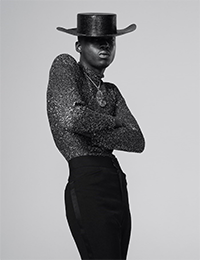
"Creating a one-of-a-kind
experience that unlocks the
next level to personalization
of shopping with a lasting
effect.”
Fashion technology partners who offer solutions that span all the above concerns, combined with a business model that will assure sustainable profitability for the partners as well as the luxury brands, are well positioned to take advantage of the changes in the retail luxury market and provide both short and long-term growth opportunities for investors. This is even more true if their product and service offerings are based on unique technology backed by protected intellectual property that will pose a significant barrier to entry to others.
There have been a proliferation of start-ups and midsize firms over the years pursuing virtual try-on solutions for online and traditional retail markets. Many have announced products and/or services that touch on one part or another of a complete solution, however current platforms have left both brands and customers wanting more and expecting better.
Modern Mirror is designed to assist in reinvigorating the luxury experience to offset e-commerce ennui, bridge the online and offline experience and establish a visionary new standard for luxury retail while staying true to the art of fashion. Modern Mirror is a brand partner throughout the journey of a garment, from the first sketch to the runway, and every step in between and after.
At the forefront of fashion and technology, it is a truly singular virtual fitting experience. Through the Avant-Garde Fitting System (AFS), consumers experience how clothing looks, fits and wears without ever stepping into an ordinary fitting room through the use of 3D body-imaging and visualization technology. The digitized representations are not simply ubiquitous avatars, they’re the consumers’ exact virtual selves, complete with their shape, dimensions, details and movements. Delivering an enhanced, immersive luxury brand retail experience both in-store and online, which positively influences consumer purchasing behaviors, anytime, anyplace on any device.
The initial 3D creation process itself creates an engaging, memorable and elevated in-store experience for a brand, while the business advantage lies in the enhancement of consumer engagement, increasing brand loyalty, as well as dramatically reducing return rates and waste. As the consumer engages more, taste profiles and new behavioral models are built to predict style preference and better serve their future needs; at the same time aggregated analytics data enables brands to optimize production and inventory allocation to match customer preferences and regional fit demographics.
“We don’t just unlock new
customers, we give you the
keys to their minds."
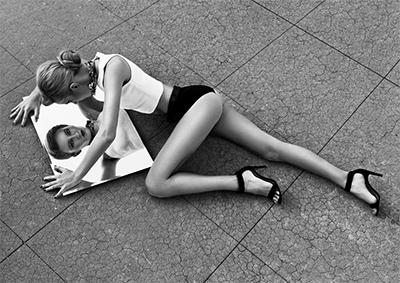
The AFS is cohesively integrated into luxury brands’ physical retail and digital platform experiences, creating a consumer-centric and unified experience for the user while respecting the art of their branding, which is paramount. As such, the bespoke experiences are crafted from the very same values, personality and behaviors of each luxury brand, offering a unique, automated end-to-end virtual try-on system, that begins with the initial design process and ends with a compelling, fit-accurate and visually-high-quality user experience.
The same technological infrastructure that powers the AFS offers added value for brands. Modern Mirror’s B2B Virtual Runway system creates virtual fashion shows using digital models captured by a 3D imaging system or a single photo, wearing the latest collections in digital form without the need for physical models or garments. The audience is provided with an up close and personal interactive show to increase their engagement with a brand’s collection, while saving on the cost of a physical show and achieving sustainability goals. Orders can then be captured through the B2B Virtual Marketplace, which provides an eminent buying process for retail buyers by having them immersed in a brand experience through a world of customized line sheets, galleries, audio and virtual runway shows, that eliminate the need for physical buyer presence at fashion shows. Brands can fully curate their marketplaces with their desired look and feel.
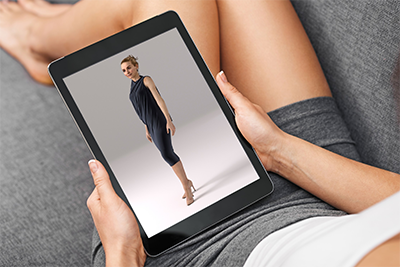
Photo Credit: Modern Mirror AFS Design By Maria Grachvogel
“In our world as we know it today, it is imperative
that we inspire innovation and luxury in the
fashion industry by changing one fitting room
at a time through elevated technological
experiences that will positively impact our
environment, social surrounding and economy."

CEO & President
A CEO with a diverse background in the fashion industry ranging from modelling, design and pattern making, product launching, visual merchandising, runway shows, and styling. “Creating a one-of-a-kind experience that unlocks the next level to personalization of shopping with a lasting effect.”
CONTACT US TO BE a featured contributor
press@themodernmirror.com